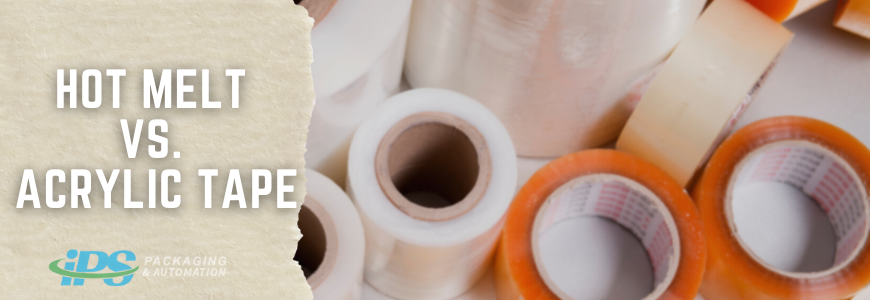
Box Tape: Hot Melt vs. Acrylic Tape
Tape can be misleading. It seems like one of the simplest packaging products out there – just peel some off, slap it down, and call it a day, right? Not quite. Sure, this might be the case for your most basic Scotch tape (and there’s nothing wrong with that!), but when it comes to tape for boxes at your business or in your warehouse, things get a little more complicated. Not all packaging tape is created equal, which is why it is so important to understand the key differences between the most common varieties. Read further for the full breakdown on two immensely popular types of box tape – hot melt tape and acrylic tape.

Hot Melt Tape
Hot melt adhesive tape, which is also frequently referred to as hot melt carton sealing tape or hot melt glue tape, is a box sealing tape that you’ll regularly come across. It is known for its impressively quick initial tack with superior holding power, high rate of adhesion, and exceptional tensile strength. Hot melt tapes are made of thermoplastic polymers and consist of three separate layers – a film layer, a special release coat for easy unwind, and an aggressive adhesive layer.
Here are the key details to know:
- An ideal choice for machine-grade applications, overly full cartons, and corrugated boxes with a high percentage of recycled material
- Performs well between 45- and 120-degrees F
- Easy to unwind
- Provides reliable seals
- Highly flexible
- Available in hand- and machine-grade tapes
- Most often utilized for shipping, storage, and carton sealing
Generally speaking, hot melt carton sealing tape is stronger than its acrylic counterpart, making it a better choice for bulky or heavy boxes.
Acrylic Tape
Acrylic tape is also often called acrylic adhesive tape. It is constructed from acrylic resins and made up of two distinct layers: a film backing with an emulsion acrylic adhesive. Acrylic packaging tapes are best known for their performance capabilities in extreme temperatures and weather conditions, as well as their outstanding work sealing a wide range of cartons.
Take a look at all of the details you need to know about acrylic box tape:
- Perform exceptionally well in temperatures between 32- and 140-degrees F
- The ideal choice for both low and high humidity settings
- Highly resistant to oxidation, meaning they won’t yellow with age and do well when exposed to sunlight
- Available in hand and machine grade
- Most often utilized for long term storage in unpredictable or varying temperatures, lightweight case sealing, and in refrigerated settings
If your cartons and products are often subjected to temperature highs and lows or you can’t guarantee what external conditions will be like in your storage facilities, acrylic tape for boxes is the way to go.
Hot Melt Tape or Acrylic Tape?
Determining which box tape will work best for your business and the goods you store and transport isn’t as straightforward as many initially believe. Thankfully, when it comes to hot melt tape vs. acrylic tape, there are some clear differences that can assist you in making the final decision. Those seeking the most strength they can get and who aren’t worried about sun or weather exposure should absolutely consider hot melt carton tape. Meanwhile, anyone who ships or stores refrigerated products or who may end up keeping items outdoors should instead opt for acrylic box tapes. No matter what kind of box or carton sealing tape you may need, IPS Packaging & Automation is always here to help.
Contact one of our expert packaging specialists today for all the info!


